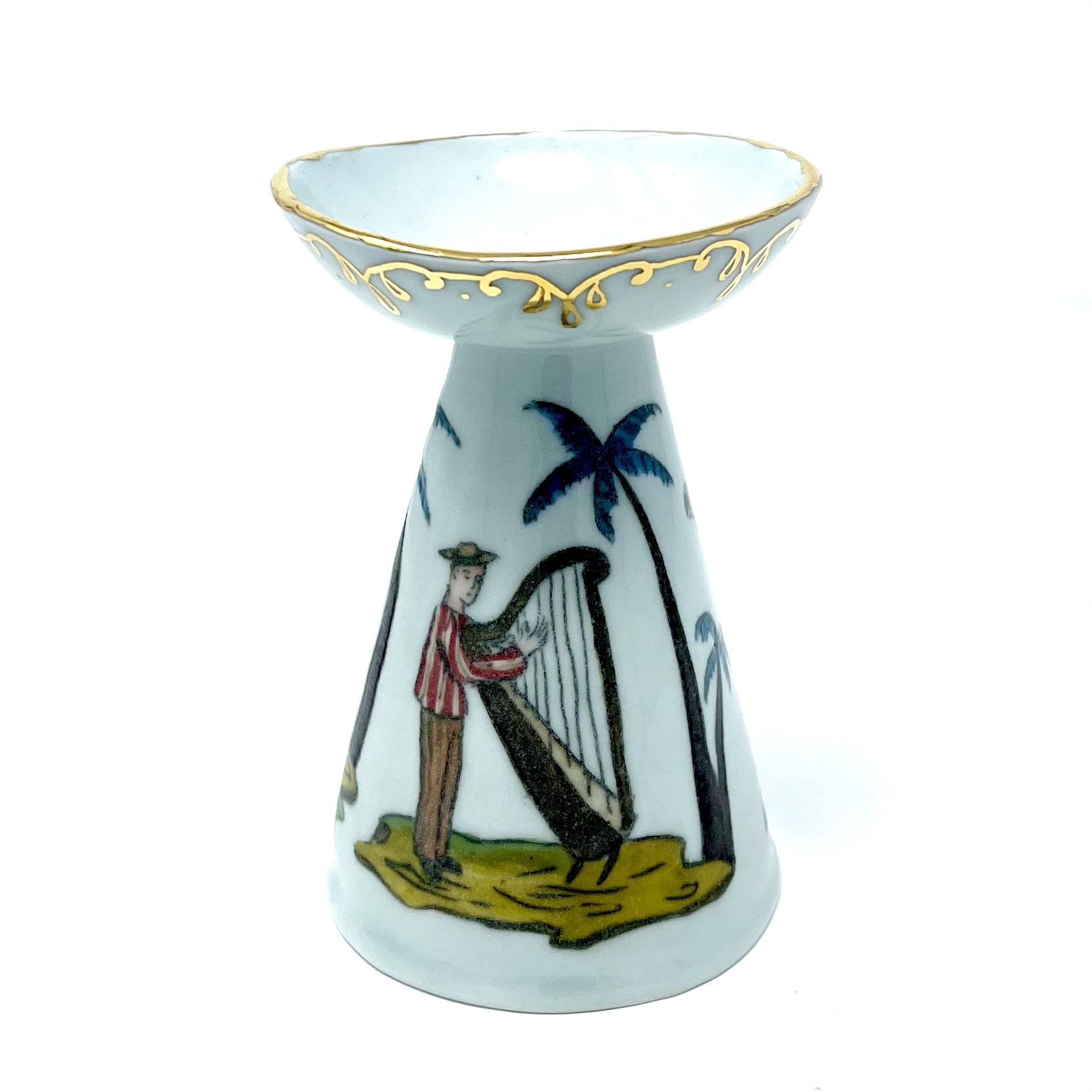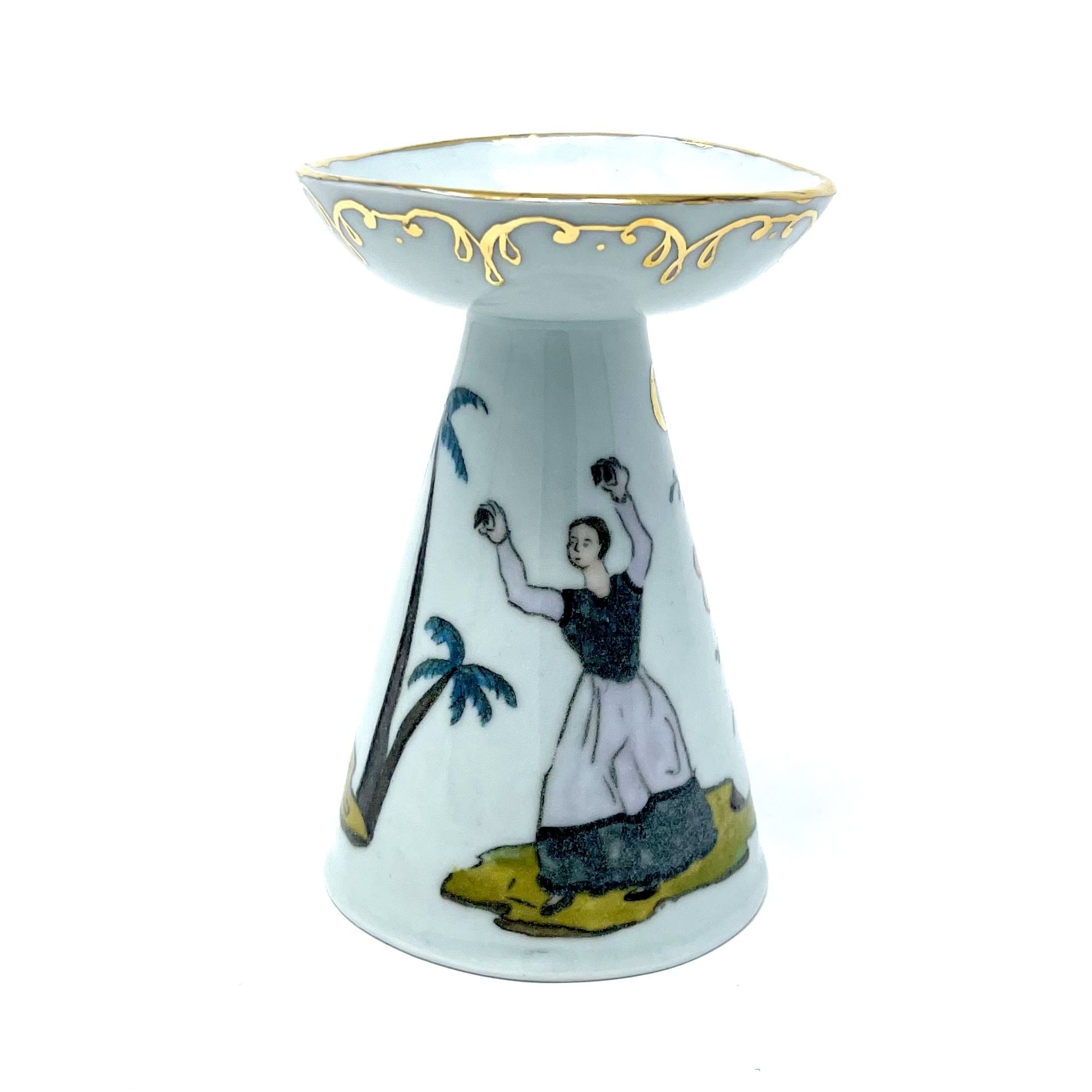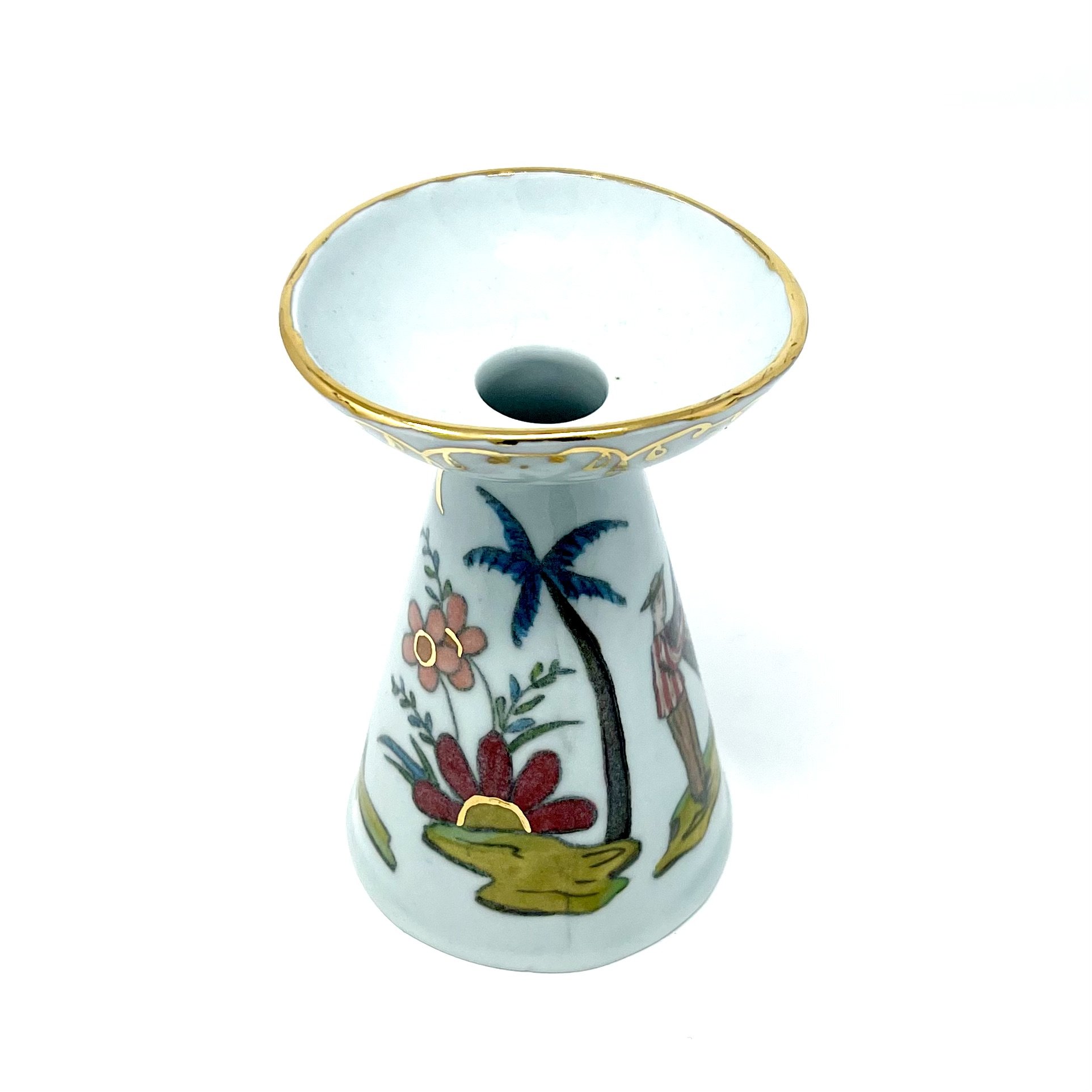 Image 1 of 5
Image 1 of 5

 Image 2 of 5
Image 2 of 5

 Image 3 of 5
Image 3 of 5

 Image 4 of 5
Image 4 of 5

 Image 5 of 5
Image 5 of 5






Petit Lampe de Nuit with Fandango
The “Lampe de Nuit” is a type of nightlight used during the 18th century. The vase is filled with water and a candlestick is placed inside, with the water level to the edge. As the candle burns, it slowly floats up, until the stump rolls over and is extinguished. At least that’s what happens most of the time, so please only use this candle with supervision, like any other open flame. The design of the Lampe de Nuit also catches the wax drippings into its bowl of water, for easier cleanup.
The scene is inspired by the rich history and incredible reach of this popular dance. I first heard of the Fandango in my California history classes growing up. Fandangos were danced throughout mission and Mexican era California, each of the three Spanish viceroyalties, Spain, other parts of Europe, and the Philippines. The fandango lives on today in many of parts of the world, such as Venezuela (where at some point the name changed to Joropo), the Philippines (the Pandanggo is played in folkloric dance), and in my living room, where I’m learning various 18th century fandangos for the Salterio. The fandango’s history and dissemination is a perfect subject to be painted on porcelain, a material with an equally interesting and cross cultural history.
“Two persons were upon the floor dancing “el Jarabe”… The attitude of the female dancer was erect, with her head a little inclined to the right shoulder, as she modestly cast her eyes to the floor, whilst her hands gracefully held the skirts of her dress, suspending it above the ankle so as to expose to the company the execution of her feet. Her partner… was under full speed of locomotion, and rattled away with his feet with wonderful dexterity. His arms were thrown carelessly behind his back, and secured, as they crossed, the points of his serape, that still held its place on his shoulders. Neither had he doffed his “sombrero,” but just as he stood when gazing from the crowd, he had placed himself upon the floor… the room was about fifty feet in length, and twenty wide, modestly furnished, and it’s sides crowded with smiling faces. Upon the floor were accommodated the children and Indian girls, who, under close vigilance of their parents and mistresses, took part in the scene… These fandangos usually hold out till daylight…”
-Alfred Robinson, California, 1847
Dimensions: 5 1/4” tall x 3 3/8” base diameter
Porcelain, 22k gold accents
Made by hand in NYC
The “Lampe de Nuit” is a type of nightlight used during the 18th century. The vase is filled with water and a candlestick is placed inside, with the water level to the edge. As the candle burns, it slowly floats up, until the stump rolls over and is extinguished. At least that’s what happens most of the time, so please only use this candle with supervision, like any other open flame. The design of the Lampe de Nuit also catches the wax drippings into its bowl of water, for easier cleanup.
The scene is inspired by the rich history and incredible reach of this popular dance. I first heard of the Fandango in my California history classes growing up. Fandangos were danced throughout mission and Mexican era California, each of the three Spanish viceroyalties, Spain, other parts of Europe, and the Philippines. The fandango lives on today in many of parts of the world, such as Venezuela (where at some point the name changed to Joropo), the Philippines (the Pandanggo is played in folkloric dance), and in my living room, where I’m learning various 18th century fandangos for the Salterio. The fandango’s history and dissemination is a perfect subject to be painted on porcelain, a material with an equally interesting and cross cultural history.
“Two persons were upon the floor dancing “el Jarabe”… The attitude of the female dancer was erect, with her head a little inclined to the right shoulder, as she modestly cast her eyes to the floor, whilst her hands gracefully held the skirts of her dress, suspending it above the ankle so as to expose to the company the execution of her feet. Her partner… was under full speed of locomotion, and rattled away with his feet with wonderful dexterity. His arms were thrown carelessly behind his back, and secured, as they crossed, the points of his serape, that still held its place on his shoulders. Neither had he doffed his “sombrero,” but just as he stood when gazing from the crowd, he had placed himself upon the floor… the room was about fifty feet in length, and twenty wide, modestly furnished, and it’s sides crowded with smiling faces. Upon the floor were accommodated the children and Indian girls, who, under close vigilance of their parents and mistresses, took part in the scene… These fandangos usually hold out till daylight…”
-Alfred Robinson, California, 1847
Dimensions: 5 1/4” tall x 3 3/8” base diameter
Porcelain, 22k gold accents
Made by hand in NYC
The “Lampe de Nuit” is a type of nightlight used during the 18th century. The vase is filled with water and a candlestick is placed inside, with the water level to the edge. As the candle burns, it slowly floats up, until the stump rolls over and is extinguished. At least that’s what happens most of the time, so please only use this candle with supervision, like any other open flame. The design of the Lampe de Nuit also catches the wax drippings into its bowl of water, for easier cleanup.
The scene is inspired by the rich history and incredible reach of this popular dance. I first heard of the Fandango in my California history classes growing up. Fandangos were danced throughout mission and Mexican era California, each of the three Spanish viceroyalties, Spain, other parts of Europe, and the Philippines. The fandango lives on today in many of parts of the world, such as Venezuela (where at some point the name changed to Joropo), the Philippines (the Pandanggo is played in folkloric dance), and in my living room, where I’m learning various 18th century fandangos for the Salterio. The fandango’s history and dissemination is a perfect subject to be painted on porcelain, a material with an equally interesting and cross cultural history.
“Two persons were upon the floor dancing “el Jarabe”… The attitude of the female dancer was erect, with her head a little inclined to the right shoulder, as she modestly cast her eyes to the floor, whilst her hands gracefully held the skirts of her dress, suspending it above the ankle so as to expose to the company the execution of her feet. Her partner… was under full speed of locomotion, and rattled away with his feet with wonderful dexterity. His arms were thrown carelessly behind his back, and secured, as they crossed, the points of his serape, that still held its place on his shoulders. Neither had he doffed his “sombrero,” but just as he stood when gazing from the crowd, he had placed himself upon the floor… the room was about fifty feet in length, and twenty wide, modestly furnished, and it’s sides crowded with smiling faces. Upon the floor were accommodated the children and Indian girls, who, under close vigilance of their parents and mistresses, took part in the scene… These fandangos usually hold out till daylight…”
-Alfred Robinson, California, 1847
Dimensions: 5 1/4” tall x 3 3/8” base diameter
Porcelain, 22k gold accents
Made by hand in NYC

